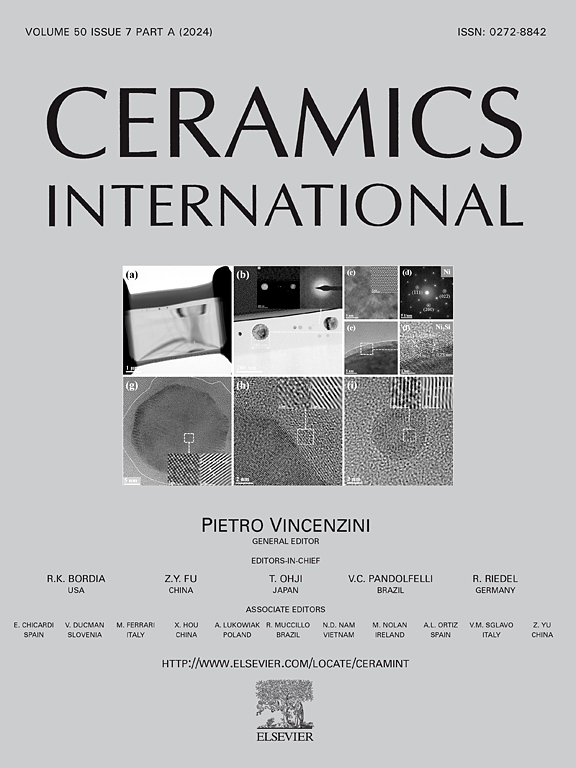Plasma formation during flash sintering of boron carbide – Part II: Effect on sintering and optimisation of process variables
IF 5.1
2区 材料科学
Q1 MATERIALS SCIENCE, CERAMICS
引用次数: 0
Abstract
Field assisted sintering techniques, such as Flash Sintering (FS), allow rapid heating and densification of ceramics within seconds at significantly reduced environmental temperatures. FS of oxides has been extensively researched since 2010, whereas the potential densification of non-oxides such as carbides is rarely investigated. In the first part of this investigation the atmospheric breakdown and plasma formation under FS-conditions relevant to SiC and B4C was researched. In the present work, the FS of B4C was investigated with and without plasma formation for comparison, and the influence and optimum combination of the other main FS-parameters determined. The results showed that at a furnace temperature of 1500 °C, it is possible to densify B4C by DC FS with or without an initial plasma formation. However, though plasma formation did not itself lead to densification of the material, the plasma-induced removal of the B2O3-layer on the surface of the powder led to a significant improvement in subsequent densification during FS. The effect of the Ar-plasma generated in removing the surface oxide from B4C-particles was confirmed by SEM and XPS. Other process variables such as carbon additives, thermal insulation and hold time also significantly influenced the densification of B4C by FS. With the optimised conditions, 96 % dense B4C, with a grain size of 10 μm and a hardness of 31 GPa (HV1) was produced by pressureless FS in 5 min at a furnace temperature of 1500 °C.
求助全文
约1分钟内获得全文
求助全文
来源期刊

Ceramics International
工程技术-材料科学:硅酸盐
CiteScore
9.40
自引率
15.40%
发文量
4558
审稿时长
25 days
期刊介绍:
Ceramics International covers the science of advanced ceramic materials. The journal encourages contributions that demonstrate how an understanding of the basic chemical and physical phenomena may direct materials design and stimulate ideas for new or improved processing techniques, in order to obtain materials with desired structural features and properties.
Ceramics International covers oxide and non-oxide ceramics, functional glasses, glass ceramics, amorphous inorganic non-metallic materials (and their combinations with metal and organic materials), in the form of particulates, dense or porous bodies, thin/thick films and laminated, graded and composite structures. Process related topics such as ceramic-ceramic joints or joining ceramics with dissimilar materials, as well as surface finishing and conditioning are also covered. Besides traditional processing techniques, manufacturing routes of interest include innovative procedures benefiting from externally applied stresses, electromagnetic fields and energetic beams, as well as top-down and self-assembly nanotechnology approaches. In addition, the journal welcomes submissions on bio-inspired and bio-enabled materials designs, experimentally validated multi scale modelling and simulation for materials design, and the use of the most advanced chemical and physical characterization techniques of structure, properties and behaviour.
Technologically relevant low-dimensional systems are a particular focus of Ceramics International. These include 0, 1 and 2-D nanomaterials (also covering CNTs, graphene and related materials, and diamond-like carbons), their nanocomposites, as well as nano-hybrids and hierarchical multifunctional nanostructures that might integrate molecular, biological and electronic components.
 求助内容:
求助内容: 应助结果提醒方式:
应助结果提醒方式:


